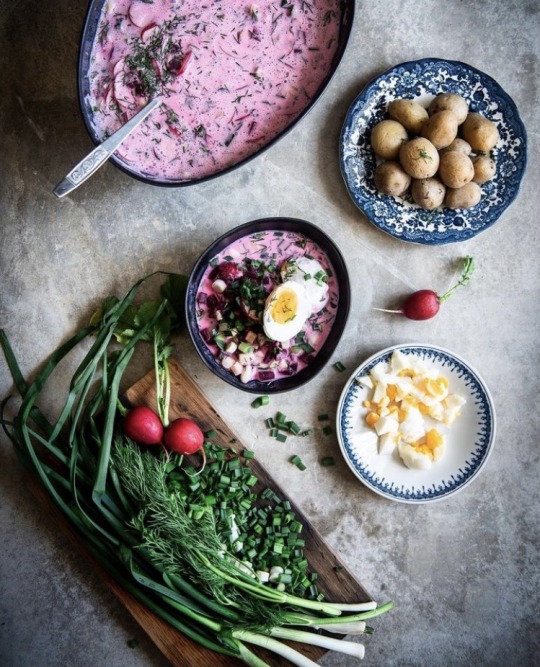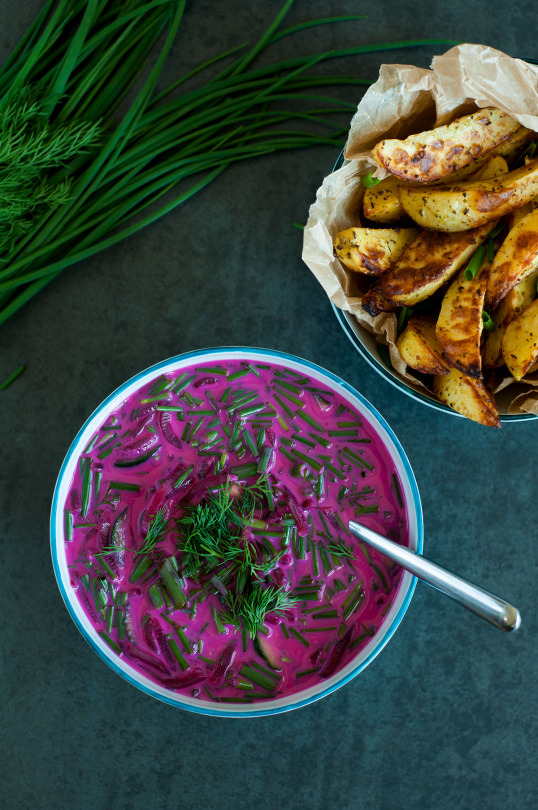#Lithuanian cuisine
Text

@dduane bought these the other day, from one of the local supermarkets which stock Central / Eastern European things. Their label indicated their origin as Lithuania, but was entirely in English and described them, rather unhelpfully, as "mini meat pies".
They were more or less ready to eat, since "cooking" instructions called for no more than about 3-4 minutes in a hot oven, and very good they were, definitely finger-food to be consumed in about two bites.
They had a smoked meat filling, sufficiently unusual for "meat pies" that it started DD trying to find out what they REALLY were. Various helpful folk on Bluesky suggested various things (links are to recipe pages):
"kibinai", which are more similar in appearance to Cornish pasties than to these shiny little nibbles, and made with (unsmoked) mutton and onion.

"speķa pīrādziņi" or "speķrauši", smoked bacon dumplings from Latvia, so there's the flavour profile, but yet again a slightly different appearance.

"kolach" or "koláč" - I've given no recipe link because these are either sweet in their original version, or similar to a sausage roll in their American version, and in any case are Czech which takes them a lot further from Lithuania than Latvia is.
We've concluded that the ones we bought and devoured were probably lašinėčiai / ausytes or "bacon buns" - the taste would be right, the visual similarity is there, and in this photo needs only an egg wash to get shiny.

Why such determination to find out what they were?
(1) Curiosity.
(2) Intention to make them at home.
(2a) Intention to include a LOT more filling than the commercial ones, which were very good but gone too soon...
:->
100 notes
·
View notes
Text

Vegan Chlodnik (Cold Beetroot Soup)
#vegan#appetizer#lunch#polish cuisine#Lithuanian cuisine#Central European cuisine#soups#chlodnik#veganized#beets#radishes#vegan yogurt#cucumber#dill#plant milk#lemon#green onion#black pepper#sea salt#💗
27 notes
·
View notes
Text




"The world's longest šaltibarščiai table, connecting Vilnius with Lublin💗! Fortunately, we didn't actually have to build such a loooooong table – we teleported the other end of it via a magical (kinda) portal from Lithuania to Poland. Vilnius Pink Soup Fest is on June 1st, so don’t miss out!"
7 notes
·
View notes
Text

Chłodnik - Polish Cold Beet Soup (recipe in Polish)
#chłodnik#soup#beet soup#polish cuisine#polish food#food#poland#chlodnik#cold soup#food photography#foodblr#dinner#polish lithuanian commonwealth#beet#eggs#egg#delicious#easyrecipes#recipe#soupblr
22 notes
·
View notes
Text
None of these are even rly lithuanian foods.....where are the cepelinai wheres the grybai wheres the kugelis wheres the saltibarsciai WHERES THE GIRA........
#'lithuanian cuisine - famously known for chocolate' a guy who's only ever been to tourist shops in vilnius#very telling that the signs are in english#i guess porridge? but like thats not smth unique other than like. preferring buckwheat
13 notes
·
View notes
Text
Looked further into this with an EXTREMELY specific website where the results seem like they're meant to be read by geneticists
Apparently, I match the most with the Lithuanian population...? But aren't they Baltic...? I GUESS it's close enough to the Slav Zone where I got thrown in there generally? There's so much to this specific test (the are a NUMBER of different models, some of them for specific areas.)
This mystery... what the fuck
#advanced deltawave#Anyway I'm gonna look up Lithuanian cuisine because this is the most important thing about this#I was just curious about this specific thing.#Fun fact! The second highest European population I match with is the Romanian popularion#Portugal and France come after these. Which is still fucking weird
0 notes
Note
Alfred, what is your favorite thing each of your roommates has brought over to your country? And to Ireland, Romano, and Lithuania, what is your favorite thing about America? (the country not Alfred.)



As for the others...


Alfred can afford to be a little more idealistic, but that's just his way.
**Historical Note: Though immigrants from each of these groups contributed in a variety of ways, these are some of the ways in which they contributed most prominently.
Irish Americans were incredibly active in the entertainment industry, especially in music. Irish Americans were very prominent in vaudeville, and eventually Broadway. However, this was due to a pre-existing music tradition that stemmed from Irish immigrants bringing over their folk music. Many Irish airs became popular parlor songs in the UK, America, and Canada. The strong Irish presence in the Union Army during the Civil War also further popularized folk songs such as "McLeod's Reel." Though the Potato Famine caused the decline of traditional music in Ireland, many songs and playing styles were preserved by Irish Americans in the United States and later carried back to Ireland in the 1890s-1920s when recordings began to become accessible. These recordings were also among the first to be sold in the United States.
Italian American cuisine is one of the most influential marks left by the community, especially from Southern Italians. Many innovations in Italian cuisine occurred in the United States, and many Italian immigrants became successful restauranteurs. This explosion occurred due to previously inaccessible foods suddenly being affordable in the United States, such as meat and imported cheese. Today, Italian American food is still one of the most popular cuisine choices in the United States.
Though all of the groups mentioned had involvement in labor union activity, Lithuanian Americans were particularly prominent activists. One of the most famous of these activists was Emma Goldman, but there were several others who formed the United Mine Workers and the Amalgated Clothing Workers Union. Sydney Hillman, a Lithuanian immigrant, was the head of the Amalgated Clothing Workers Union from the 1910s to the 1940s. Even in fiction, in Upton Sinclair's The Jungle, Lithuanian workers and their union activity are the central focus. Lithuanian Americans' strongest import really seemed to be their activism!
For all of these groups though, one big part of what made American so attractive was the comparative plenty to what they had in their countries of origin. Though many immigrants worked long, difficult manual labor jobs, they were able to afford new goods in the United States that had previously been unimaginable. This is mostly due to the United States' ability to produce goods en masse, which made them cheaper. Furthermore, in Ireland and Southern Italy, land ownership had become virtually impossible (through landlords hiking rent prices in Ireland or land distribution after the Risorgimento in Italy). Even if their positions were not enviable in the United States, from a financial standpoint, their salaries and the resources available put them in a slightly better position.
#hetalia#historical hetalia#hws america#hws romano#hws lithuania#hws ireland#nyo!ireland#immigrant trio#immigrant squad#hetalia ask blog#ask#last seminar my paper was on how the irish diaspora changed and preserved traditional music#so if i pop off a lot about that in the historical notes that is why (it is a roman empire in my brain of sorts)#this was a fun ask though! sorry for taking so long to answer!!
76 notes
·
View notes
Text
Hi there! I'm Senia 🐍
I'm a fan of the sims 3 and various horror games, as well as underground cinema, Lithuanian literature and Chinese cuisine 🥮
If I stay here, I will from time to time share my thoughts, photos of culinary experiments, travel and something else interesting, such as the process of creating a comic book in ts3, for example 🖥️
I will be glad to meet new people and I will be happy to subscribe to your blog ✨
Всем привет! Меня зовут Сеня. Буду рада новым знакомствам больше, чем реакциям 💜

Свои фотографии и интересные музыкальные подборки публикую в группе (ссылка ниже). Заглядывайте на огонёк 📸
14 notes
·
View notes
Text
It makes sense that tolys works out a ton. I mean have you seen Lithuanian cuisine it's basically bacon and potatoes and meanwhile Tolys is canonically well built
But also I semi half jokingly think someone told him that working out relieves stress he took the advice but exercise can only lower so much when your stress is astronomical
14 notes
·
View notes
Text
there was a poll about root beer, but i'm curious about

this baby.
as opposed to root beer, kvass can't be easily connected to one specific country; instead, there are many regions and cuisines associated with it. therefore, to make the poll easier, the regions whose cuisines are associated with kvass (belarussian, estonian, latvian, lithuanian, polish, russian, ukrainian, and uyghur, and also finnish and swedish because the wikipedia article also lists them) shall be the Kvass Regions™.
originally i had separate options for "i like/love it" and "i'm ambivalent"=if there was no other option, i'd drink it, but i don't actively choose it out of other beverages" but it looked like Too Many Options for me, so now "like it just fine" = both "i love it" and "eh, drinkable". yeah i'm shamelessly copying the root beer poll u_u
elaborate on your opinion in the tags, if you desire so!
#shrimp thoughts#PERSONALLY i love it#although it has to be said i've never had one that was homemade so i was surprised when i saw the photo above. it's so light!#compared to it the ones you can buy are dark like cola and i think when i was a kid my grandma? or mother? called it a healthier polish col#lol. UNFORCHLY the way kvass tastes differs across the brands so you can get one that's properly bready in flavour and not as sweet#but also you can find one that's sweeter lighter and not as bready which imo defies the purpose!#why would i buy bread kvass if i don't want to taste bread!
13 notes
·
View notes
Text






Saltibarsciai (Cold Borscht Soup) - Soup Saturday
This refreshing, cold beetroot soup is part of traditional Lithuanian cuisine. It consists of creamy blend of pickled or boiled beetroots and tangy kefir or buttermilk, poured over grated cucumbers and hard boiled eggs. The whole soup is generously seasoned with dill, and usually left to set until all the flavours are thourougly combined.
It is usually prepared in summertime, and its best served chilled, preferable with potatoes on the side.
10 notes
·
View notes
Text

Vegan Šaltibarščiai (Lithuanian Cold Beetroot Soup)
#vegan#lunch#dinner#lithuanian cuisine#Eastern European cuisine#soups#Šaltibarščiai#beets#cucumber#dill#potato#tofu#vegan yogurt#lemon#green onion#plant milk#sea salt
20 notes
·
View notes
Text




If you ever go to Etno Dvaras in Lithuania, you NEED to try their gira (also kvas, the orange drink on the photo above), it's the Heaven's nectar🤌🤌
#Lithuania#etno dvaras#Lithuanian cuisine#світлини тайм#travel#Europe#paganism#Lithuanian art#Vilnius
1 note
·
View note
Text
Can we appreciate sour cream for how much it SLAPS. Literally the greatest thing ever because you can put that shit on almost anythinggg. Lithuanian cuisine has you to thank for being so baller.
6 notes
·
View notes
Text
Some see gefilte fish as a delicacy, others as something too disgusting to contemplate. Either way, it would probably appear on most people’s short list of classic Ashkenazi foods. For good reason. It’s been part of the Eastern European Jewish diet for hundreds of years.
The funny thing is that gefilte fish didn’t start out as a Jewish food. The first mention of gefuelten hechden (stuffed pike) comes from a 700-year-old, non-Jewish, German cookbook. In it, poached and mashed fish was flavored with herbs and seeds, stuffed back into the fish skin from which it came, and roasted. It was a popular dish for Catholics during Lent, when eating meat was forbidden.
By the Middle Ages, that Catholic dish had migrated into the Jewish kitchen under the moniker gefilte (stuffed) fish. The rabbis considered fish to be the perfect food to kick off a Sabbath or holiday meal, since fish symbolize the coming of the Messiah and fertility. Plus, for the Jewish communities in Germany and Eastern Europe, it was easy to gain access to the fresh, sweet fish that is ground to make the dish. They were surrounded by well-stocked rivers, streams, and lakes.
Gefilte fish even satisfied some religious commandments. It is prohibited to light a fire and begin cooking on the Sabbath and most holidays. Gefilte fish, happily, can be made in advance of the Sabbath day, chilled, and eaten cold. There is also an injunction against picking bones from flesh on the Sabbath, as one might do when eating fish. With gefilte fish, you get the fish without the bones.
The downside of gefilte fish is that it takes a lot of time to prepare. That pain, though, is offset with economic gain: You need a relatively small amount of fish to feed many. Before the ground fish is cooked, it is mixed with seasonings, egg, and either bread or matzah meal to bind it and stretch the fish a little further. In poor families, the family cook might ask the fishmonger for just the fish head, skin, and bones. The skin would be stuffed with bread and other fillers, the bones and head would flavor the broth.
Given how time consuming it was to grind the fish and then return it to the skin, a new kind of stuffed fish eventually emerged — one that wasn’t stuffed at all. The name remained; the method changed. Fish was shaped into patties and poached in a seasoned fish broth.
Over time, gefilte fish became synonymous with the shtetl and with Sabbath and holiday meals. There were many permutations to the dish, some of which signaled where you were from. German Jews made it out of pike. Polish Jews used carp and/or whitefish. British Jews used saltwater fish like cod or haddock. Jews from southern Poland and northern Ukraine served a sweetened fish, since sugar beets were plentiful there. Lithuanian gefilte fish was heavy on the pepper. The Jews of Russia and Belarus put beets in their poaching liquid for a pink-tinged fish and broth.
As the Eastern European Jews left their shtetls, they brought their cuisine with them. Many of us have heard stories of fresh carp swimming in bathtubs on Manhattan’s Lower East Side. They were purchased from the fishmonger early in the week and left to frolic in the tub before their home sacrifice. Thursday’s fresh carp became Friday night’s first course. And it heralded the start of the Passover seder, too.
Over time, gefilte fish lost some of its appeal. Did you really want a carp in your bathtub waiting for its end? Did you really want your home reeking of the malodorous scent of fish? For some, preparing it was a triumph of old school cuisine. Others were happy to move on.
And that’s when some enterprising Jewish businessmen moved in to fill the gefilte fish void.
Shortly before the Second World War, Sidney Leibner, the son of a fish store owner, began selling ready-made gefilte fish under the name Mother’s Fish Products —first canned, and later in glass bottles. Mother’s was joined by Manischewitz, Mrs. Adler’s, Rokeach, and others. Old World met New in mass-produced jars of gefilte fish.
The bottled stuff was just palatable, but in the late 1970s, consumers were offered the chance to make their own, fresh gefilte fish without the fuss, muss, and odor: frozen loaves of ready-made gefilte fish swam in to save the day. All you had to do was boil water with carrots, onions, and celery, then pop in the frozen loaf.
As many of us have begun to look back to our roots, the food of the shtetl has made a comeback in recent years. Millennials Jeffrey Yoskowitz and Liz Alpern are leading the way with “their mission to reimagine Eastern European cuisine.” Their cookbook, “The Gefilte Manifesto,” is filled with old-world recipes including herbed gefilte fish, baked terrines of fish, and poached gefilte “quenelles,” as well as the original deal: Old World Stuffed Gefilte Fish.
As author Stephen King once wrote, “Sooner or later, everything old is new again.” As it is with life, so it is with gefilte fish.
5 notes
·
View notes
Text
nations who are good cooks
ok, i got a lot of ideas about this one too
romano: starting with the obvious. when he was living in america and working for alfred (seems like the interwar period?) he cooked for him along with being essentially a personal maid. and ofc its only natural that the representative of southern italy would be an amazing cook. in my human aus, i usually have romano either starting a restaurant or working as a chef, and in nation aus, i would imagine food is one of the areas he is never lazy in. if romano was at one point the representative of naples, than pizza would be a specialty of his (and he would have some STRONG feelings on all the different incarnations of pizza in america and arounf the world), along with pasta with seafood in it and dishes with salami. overall romano is def one of the best cooks out of all characters
antonio: ok, basically if spamano had kids their children would be blessed with amazing food no matter which parents cooking. antonio’s favorite part of cooking is watching others enjoy it. he loves having big dinners with his friends, like romano, ned, bel, francis, gilbert, and watching their reactions, seeing just how much they enjoy it. he’s kinda like when ur grandma coaxes u eat more even when ur full. and of course, olive oil is used heavily, perhaps even excessively, in all of his recipes. whenever romano asks him for a recipe for one of his dishes, antonio always refuses to give up the ‘secret ingredient,’ and everytime romano accurately guesses it’s (surprise!) olive oil
francis: i mean, he’s in the gastronomy or gastronomics or whatever they call it club in the hetalia academy episodes. and french cuisine is some of the most famous and delicious in the world. im not talking about the stupid little five-bite-and-ur-done french dishes they have at fancy restaurants, no, when francis cooks, it’s hearty, delicious, and filling. he’s especially skilled at making soups (even arthur cant deny that his french onion soup is absolutely amazing), quiches, and ratatouille, lots of so-called peasant dishes that will leave you full for hours and will make u feel warm and satisfied
sadik: yet another member of the gastronomy club in the hetalia academy episodes, sadik cooks very frequently in his free time (he’s another character who i often make a chef in my human aus). turkish cuisine, much like turkish culture, is influenced by a variety of different sources, like european, middle eastern, and asian, so i imagine that sadik is adept at cooking foods of different cultures around the world, and likes to incorporate flavors he considers ‘exotic’ into his dishes
yao: yao is shown to immediately want to care for people around him who are sick (such as immediately running to care for kiku when he has a cold) and i imagine him cooking for others is a big part of that natural instinct to care for those around him. now, im unfortunately only familiar with westernized chinese cuisine (which i hc that bc of yao’s appreciation of china towns and chinese diaspora around the world he would still enjoy westernized chinese food), so i cant really comment on specific authentic dishes, but think of warm soups and light snacks. those are his specialities. 
tolys: i imagine that in soviet times, ivan had tolys doing a million things at once, including being a personal assisstant/secretary, cleaning the house, and cooking. i dont think tolys would love cooking or consider it a hobby, rather something that needs to be done bc people need to eat, but after years of cooking for the other bloc nations, he’s grown pretty good at making a variety of eastern european dishes, like russian pelmeni, polish pierogi, lithuanian beet soup, or ukrainian borscht, whatever ingredients he could get his hands on and whatever he could do to make the other bloc nations feel at home
gilbert: i only include gilbert bc i feel like although he wouldn’t be an amazing cook, he would be adept at throwing together an edible meal from found ingredients and anything he can get his hands on. the mans been a warrior/soldier his whole life, armys are not generally famous for their cuisine, so i bet over the centuries he’s become good at improving meals with found ingredients. he could make a decent meal out of some shit he found in the wilderness. i also bet hes amazing at making one specific dish—not sure what it is yet, still have to pick one — but just one specific food he can make on special occasions and everyone is blown away that ‘wow! gilbert can cook?’
39 notes
·
View notes